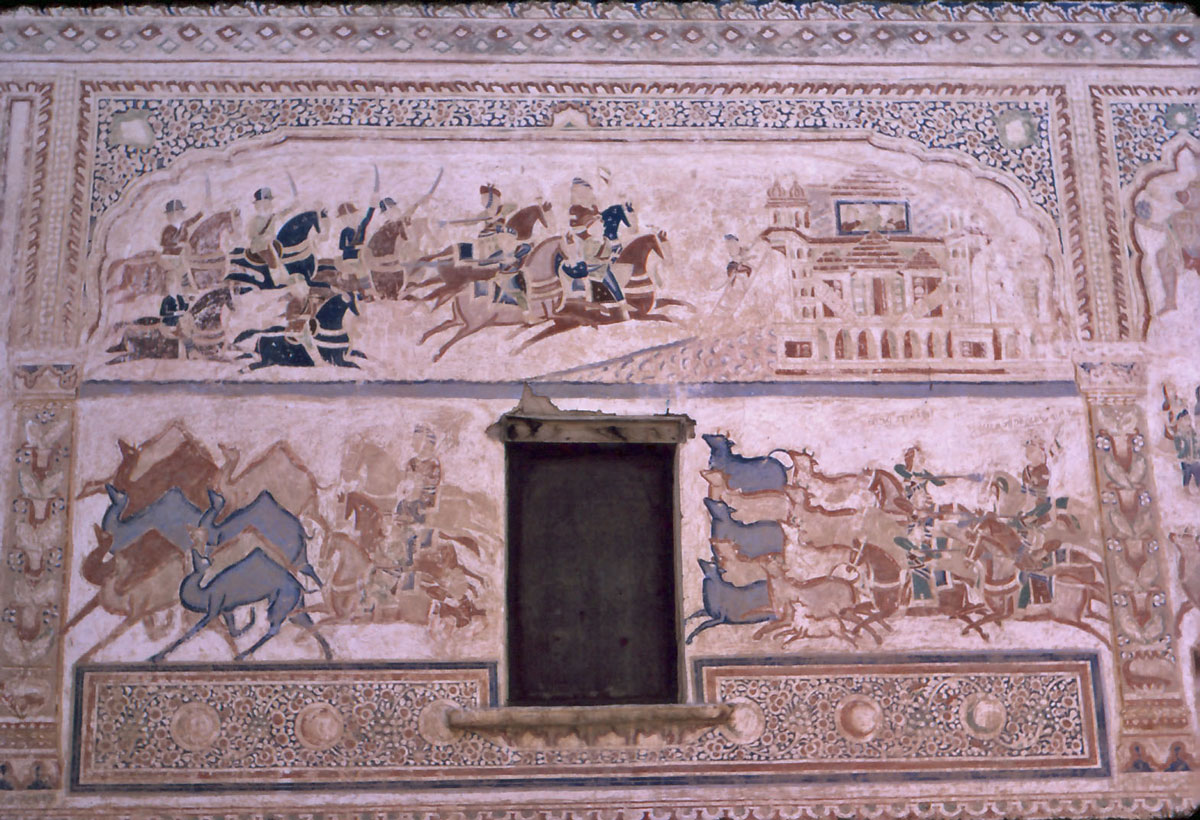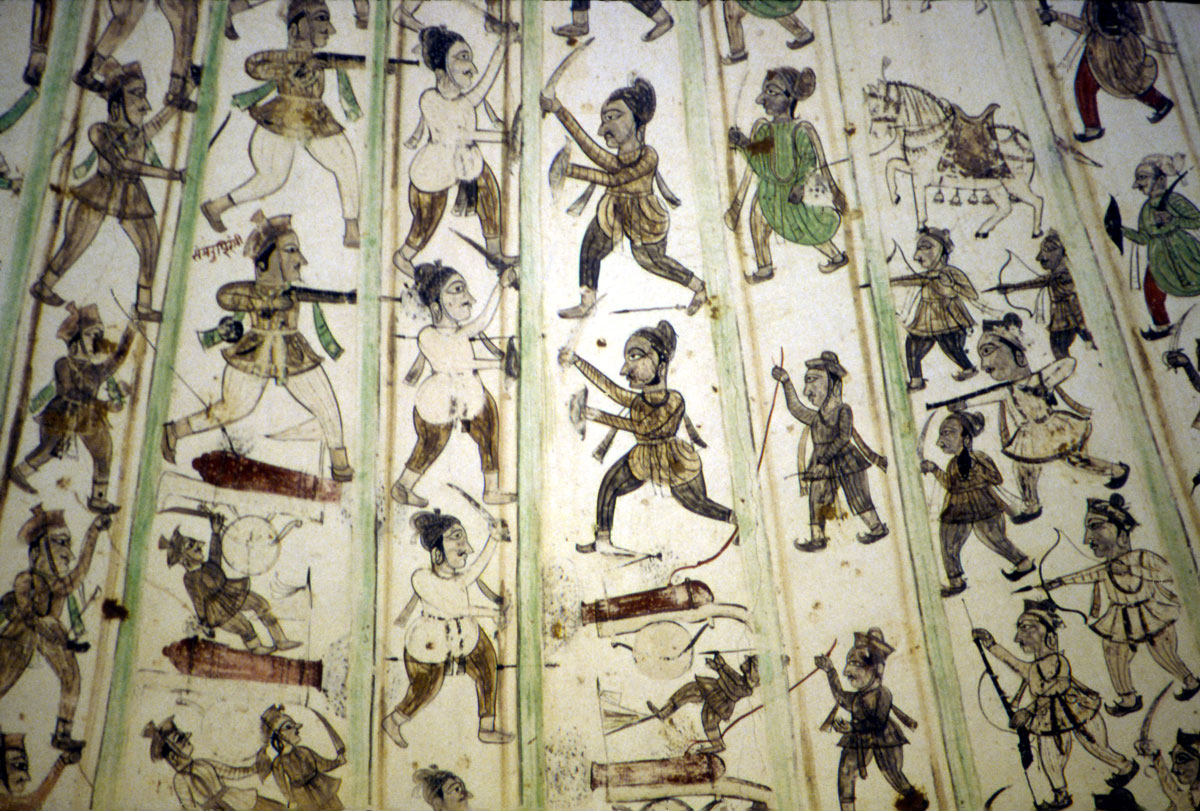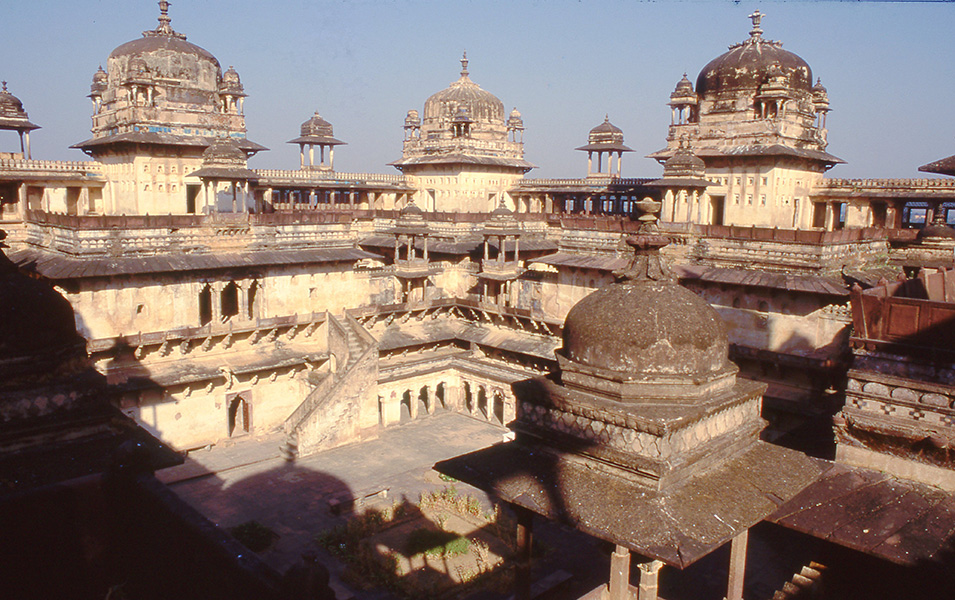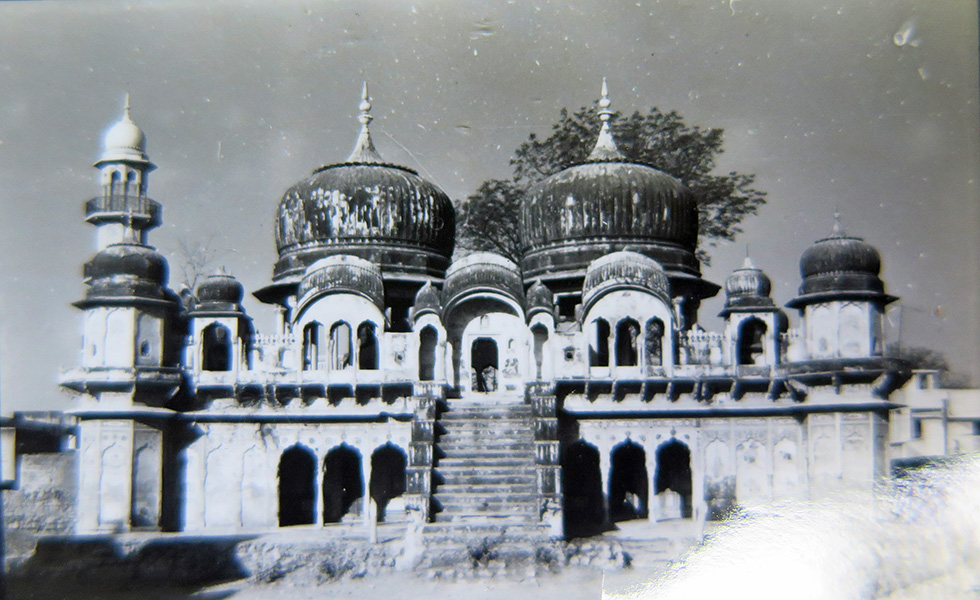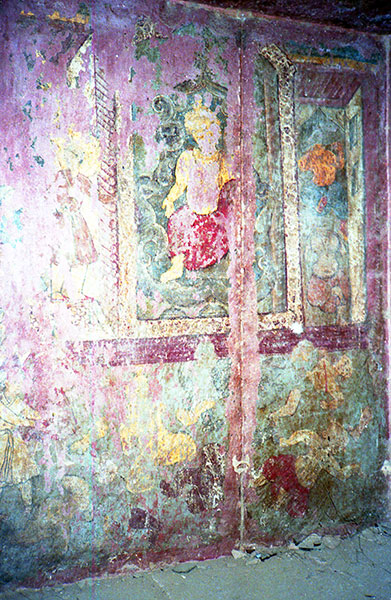22. Half Forgotten Rajasthani History
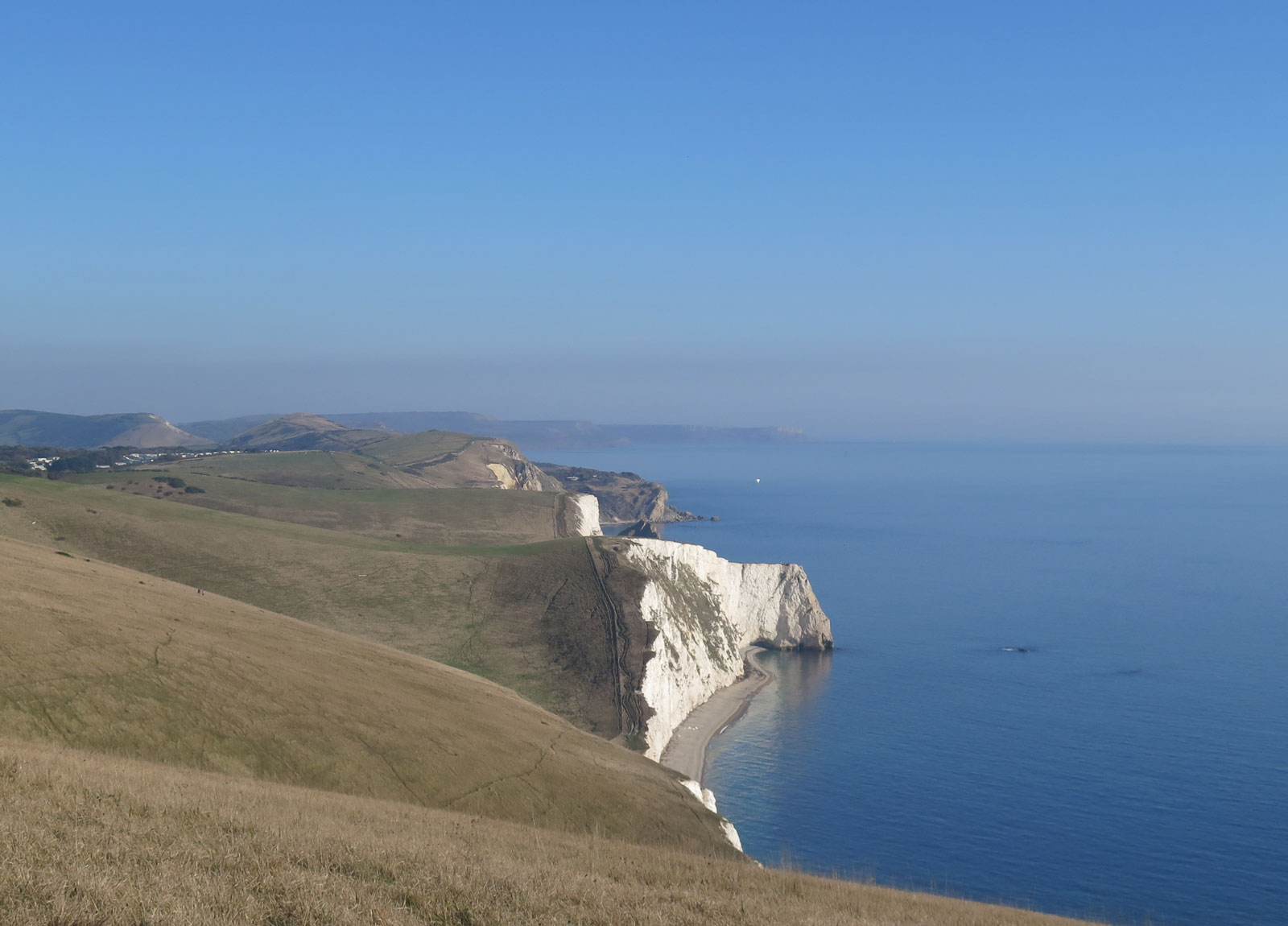
21. A Walk To Weymouth 2
September 17, 202023. Early Foreign Visitors To Shekhawati 1
October 1, 2020O nce settled in Churu my time was devoted to exploration. The murals had become an obsession, which was not confined to quirky 19th century pictures. There were older murals either in an angular folk idiom or the refined work of trained itinerant artists.
The Rawal Sahib of Nawalgarh mentioned the memorial chhatri of Sardul Singh at Parasrampura, the thakur (Hindu baron) who displaced the Muslim Nawab of Jhunjhunu. His estate was divided among five sons, one being Rawal Sahib's ancestor. That chhatri, completed in 1750, is a gem. Stepping up into its 12 pillared dome one is surrounded by lively ochre and black figurative paintings in a very individual style. They include pop-eyed Sardul Singh and events from his life intermingled with episodes from the Ramayana epic. A few miles away is an older chhatri, its murals similar but not so skilled, dedicated to Prem Singh, a Rajput who saved Sardul Singh from assassination.
Sardul Singh built a temple nearby but died in 1742 while it was being painted; this offers another point of interest. The artists, realising his heirs wouldn't pay, abruptly stopped work. Their unfinished murals show how they worked. On the dry plaster of a vaulted ceiling completed pictures run into ochre outlines of planned scenes. On the central ceiling are roundels of angels next to incomplete ones roughly drawn in charcoal, corrected in red ochre and again corrected. The final pigments would have hidden those initial sketches. Clearly these men drew freehand and altered as they advanced.
There is high quality figurative work in my adopted town, Churu, too, in the Eight-Pillar Chhatri near the vegetable market. This has an inscription dated 1776 naming the builder (and painter?) as Sukha Kumhar of Khandella. The Kumhar caste embraces Hindu potters, masons and painters. The neat paintings include named religious subjects and the portrait of a Rajput thakur, presumably the man commemorated; there is even a little, hatted European carrying a musket, undoubtedly a foreign mercenary. Jhunjhunu's Bihari Temple, also dated 1776, displays very similar murals mixing religion with the events of local rulers including pop-eyed Sardul Singh and his five sons, surely more of Sukha Kumhar's work.
In the later 18th century foreign mercenaries, always infantry men, were depicted in feuding armies vying for power across a disintegrating Mughal state. To identify such scenes required more knowledge of Rajasthani history and its battles. Dated buildings and named combattants helped. The town of Ringas, between Sikar and Jaipur, poor in painted havelis, has a temple of Janki Ballabhji at its edge. On the flat roof stands an undated marble-pillared chhatri, its ceiling covered with hundreds of lively figures. One sector of the dome depicts a major battle in which several of the important figures are named. An elephant on one side carries 'Jawahar Singhji'; his infantry includes many Europeans; the largest of these, with a little pointed beard, is named as 'Samru Faranghi' – Samru the Foreigner. Walter Reinhard, either German or Alsacian, was known to the French as 'Sombre', dark either in colour or in nature. Indians called him Samru. A defector from French forces, he hired himself out to various rulers. His widow, Begum Samru, became a notable personality in early 19th century Delhi. Fighting against them, also on elephants, are 'Har Sahaiji' and 'Gur Sahaiji' with the five-coloured flag of Jaipur. This army, too, has a smaller contingent of mercenary infantry. These facts should be clues enough.
The library in Jaipur's City Palace is a useful source for local history. There, in a book, 'Thirty Decisive Battles of Jaipur', I identified the battle. In 1767, the arrogant young Raja of Bharatpur decided to make a pilgrimage to holy Pushkar and, with his army, took a route straight across Jaipur state without so much as a 'by your leave'. He relied on his large infantry force led by Samru. Jaipur's sick raja, Madho Singh delegated two brothers, Gur Sahai and Har Sahai, to lead an army to chastise him. The armies met at Maonda c60 km northeast of Ringas. Bharatpur's infantry decimated the flower of Jaipur's aristocracy but Jawahar Singh was forced to retreat. The Battle of Maonda was a major event for Shekhawati since many local barons were killed. Other Shekhawati chhatri murals depict it in Singhana, Ganeri and Babai, as well as one in Rajgarh in Alwar district. At Babai there are chhatris to Raja Dalel Singh and his heir, Lachhman Singh but no memorial to his son and heir – all three were killed in the battle. Perhaps the single mercenary in Churu's chhatri, painted nine years after the event, was also intended to refer to Maonda.
Other historic episodes feature in Shekhawati's murals, among them the tales of two separate pairs of Rajput, both Robin Hood figures. Dungarji and Jawaharji achieved fame in the mid 19th century. When Dungarji was arrested Jawaharji arrranged his escape from Agra Jail. Balji and Bhoorji, from a village in Sikar distict, also prospered as bandits, raiding in Shekhawati, Jodhpur and Bikaner in the early 20th century. In November 1926, finally tracked down by troops of the Maharaja of Jodhpur, they made a last stand outside Mahansar. A memorial states that they died fighting British troops: they were not involved. Questioned, the Thakur of Mahansar told me, dacoits or no dacoits, it wasn't good to think of Rajputs killing Rajputs so the British were blamed. A contemporary mural shows only Rajputs in the pursuit. The Raja of Sikar gave 40 bighas of land in their memory. A bigha? It varies across India but is usually about 0.4 acre.
The grimmest battle pictures are in Sardarshahr and depict the First World War, grey panels of army lorries, troop transporters and battleships, one marked 'Germany Ship'. There are fewer bodies. This was organised battle with all the right machinery to carry out the slaughter. The threat was greater, the action less.

